Ball of Fire
by Howard Hawks
[DVD]
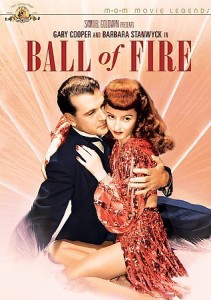
view/request
In this delightful romantic comedy Gary Cooper plays Bertram Potts, the youngest of eight professors who have lived together for years, devoting their time to the production of a new encyclopedia. When a trash collector asks the professors for help answering questions for a trivia contestd Bertram is baffled by the garbageman’s language and realizes his article on American on slang is badly out of date. In order to correct this he must leave his reference books behind in order to do some research in the field.
Bertram’s field research brings him in contact with Sugarpuss O’Shea, a witty and jocular nightclub performer portrayed by Barbara Stanwyck. Sugarpuss has no interest in helping Bertram with his research until her mob-boss boyfriend gets in trouble and she needs a place to hide from the police. What better place to hide than among these quiet and respectable professors?
Having taken refuge with the encyclopedists, Sugarpuss delights in teasing the stodgy Bertram and soon makes friends with the other professors (who, unlike Bertram, enjoy her company from the beginning). Bertram, however, worries that her presence will interfere with progress on the encyclopedia. “Now, when the Foundation launched our vessel”, he proclaims, “it very wisely followed an old rule of the sea, no women aboard. It chose a crew of single men with nothing to distract them from the course they were to sail.” Sugarpuss recognizes this as nonsense, but can’t risk a fight under the circumstances. Still, it is with evident sarcasm that she offers “to sit on her legs”.
Bertram almost redeems himself when he replies, “Make no mistake, I shall regret the absence of your keen mind”. However, he continues with, “unfortunately, it is inseparable from an extremely disturbing body.”, a statement which comes across as almost redeeming—Bertram wasn’t concerned for the sake of the other professors, but for himself. Fate will, however, keep Sugarpuss and the professor together, and despite flying wisecracks and bullets (remember the mob-boss boyfriend?) they soon grow to enjoy each other’s company.
Stanwyck’s Sugarpuss is refreshingly strong, independent, and easily the most complex character in the film. Gary Cooper’s Bertram is understated and reserved. Many of the characters come across as cartoonish, which is just what you want from the supporting characters in a screwball comedy. The dialogue is fast and witty and, of course, full of period slang, familiar and not.
By the way, Ball of FIre would later be remade as the musical A Song is Born starring Danny Kaye. The dialogue in the two films is in large parts identical, despite the different scenario and very different portrayals. Folks who have seen A Song is Born will be relieved to know that in Ball of Fire the dialogue actually makes sense!
Reviewed by Ben
Tagged: Billy Wilder, Comedy, Drama, Feature film, Howard Hawks, Jazz, Romantic comedy, Slang
Last Picture Show
by Peter Bogdanovich
[DVD]
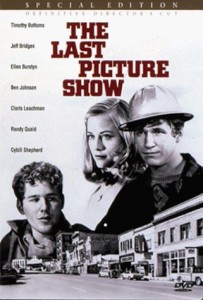
view/request
In keeping with the “New Hollywood” theme, I thought we’d take a look at another Roger Corman student and another film in the Criterion Collection’s America Lost & Found series. Following his directorial debut Targets (a brilliant “Frankensteining” of Corman stock footage of Boris Karloff and a completely new script about a local assassin), Peter Bogdanovich adapted Last Picture Show with the book’s author Larry McMurthy.
The film is set in a transitional period, both for the landscape and members of the graduating high school class, in a rural north Texas town in the early 1950’s. Timothy Bottoms, Jeff Bridges, Cybill Shephard and Randy Quaid play the local teenagers who are thinking about their futures outside of their small home town. Relationships, the military, money and taking care of family members all play important roles on these characters’ decisions. Two adult figures, Cloris Leachman and Ben Johnson, both won Oscars for their performances in supporting roles.
Robert Surtees’s soft black and white cinematography over the dusty roads and old shop signs hang a general feeling of loneliness over Last Picture Show. Bogdanvoich’s subtle humor, rich character drama and calculated pace, earn him comparison to the French master François Truffaut. He would also continue to look to the past, mostly filming in black and white, in years to come with films like Paper Moon, What’s Up Doc? and Nickelodeon.
In The Last Picture Show, we can feel that change will come in this part of Texas and that Red River shall inevitably have its final curtain.
Reviewed by Jason
Tagged: Comedy, Drama, Feature film
Judex
[DVD]
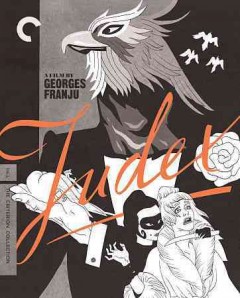
view/request
I tend to be someone who knows what he’s looking for in the stacks and will often go in with a list. We can’t always be a slave to structure though. Judex is a film I checked out based solely on the intriguing box cover. It also is a part of the Criterion Collection… so, I knew I was in for something interesting.
This 1963 French movie is an homage to a 1916 silent film of the same name. Set at the time of the original, Judex hits the ground running with a mysterious blackmail letter, a murder, strange sci-fi/occult touches and a stoic, caped man. Countless twists and turns, masks, hidden identities, a circus, knives and a lovable detective color this suspenseful caper. Furthermore, Judex is photographed in the most brilliant black and white with stylish camera angles that would make any film nerd’s heart have serious palpitations.
It pays to sometimes take chances with movies; going in blindly. However, I’ve done the work for you already on this one. So, go ahead and enjoy George Franju’s Judex!
Reviewed by Jason
Tagged: Feature film, Mystery
The We and The I
[DVD]
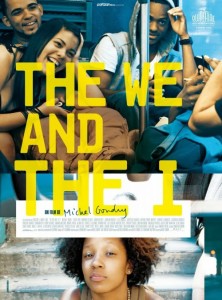
view/request
Director Michel Gondry is mostly know for his heady, comedic films with cunning in-camera effects such as Eternal Sunshine of the Spotless Mind &The Science of Sleep and innovative music videos from Björk, Beck and the White Stripes. In The We and the I, Gondry scales back and tells a story via a bus ride through the Bronx. The French director workshopped this script with a group of teens over the course of three years and the result is this wonderful film.
We see the complex dynamics of high school relationships as we join a group of students after their last day of classes. There’s bullying, gossip, swagger, flirting, fighting, some genuinely funny conversations and many heartfelt moments, too. Throughout, the dialog is natural; we almost feel as though we’re watching a a documentary at times.
Despite this austere approach to filmmaking, Gondry’s presence is still felt with the occasional use of non-digital effects. A small boombox shaped bus rides around town at the intro. Later, we see an interesting scene where he superimposes a pizza shop directly through the window of the city bus. These moments perfectly interject surrealism and introduce lightness into this very realistic movie.
Reviewed by Jason
Tagged: Feature film, New York City
A Glimpse Inside the Mind of Charles Swan III
[DVD]
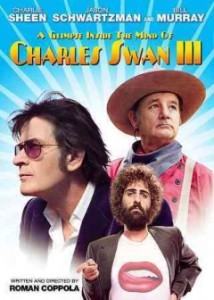
view/request
Charlie Sheen, Jason Schwartzman, Katherine Winnick, Patricia Arquette, Aubrey Plaza and Bill Murray star in this dark comedy about a graphic artist going through a painful breakup and life crisis. Charles Swan (played by Charlie Sheen) is a Brandy Alexander drinkin’ guy who has eggs and bacon decals on his old roadster, but also dreams up wild visions of soft shoeing at his own funeral, singing a duet in Portuguese on television and being attacked by models wearing Native American garb. He simply can’t distinguish reality from fantasy.
Roman Coppola, yes son of Francis Ford and brother of Sofia, is the writer/director. The film is a homemade affair with Coppola using his house and office as key locations. He also worked as the director of photography on the picture. A Glimpse Inside, though never stating such, seems to be set during a groovy time in 1970’s: airbrush, velvet suits, cool hair, shades, snazzy record album jackets, etc. In addition, the character of Charles Swan is loosely based on a few airbrush wizards from the L.A. art scene and fittingly, Swan’s studio features the work of several of these artists (including Charles White III).
The film blends off beat comedy, staged fantasy and drama. Also, be sure to listen for Liam Hayes’s brilliant score.
Reviewed by Jason
Tagged: 1970s, Artists, Feature film
Pootie Tang
by Louis C.K.
[DVD]
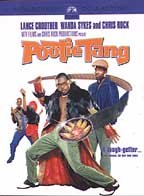
view/request
A case for Pootie Tang, a micro-essay.
Genius comic Louis C.K. had written a script based on a character from the Chris Rock Show and brought it to the big screen in 2001. It has been well documented that the author was extremely unhappy with the final product and the experience caused him a great deal of pain. You see, the film was snatched away in the editing stages and the cut we see now is not Louie’s vision.
This much maligned film stars Lance Crouther, Chris Rock (in several roles), J.B. Smoove and Wanda Sykes and also features several cameos (I’m not going to spoil them here). We follow the life of Pootie Tang, a hero to the people with a magical belt and an unintelligible language. Things go awry when an evil corporate villain, through a series of underhanded schemes, attempts to attach Pootie’s likeness to unhealthy fast food, malt liquor and cigarette smoking.
Despite the critical wrath and lampooning from late night talk shows, Pootie Tang still delivers plenty of laughs in its crazy, surreal music video-esque style. Though many cite the film as a “so bad it’s good” romp, I enjoyed the picture in the most genuine way possible. I found myself laughing loudly throughout and having to catch my breath.
I suppose this off the wall mockumentary was a little ahead of its time at the beginning of the 2000’s. Needless to say, fans would love to one day see Louis C.K.’s director’s cut to view the real Pootie Tang.
Reviewed by Jason
Tagged: Comedy, Feature film
California Split
[DVD]
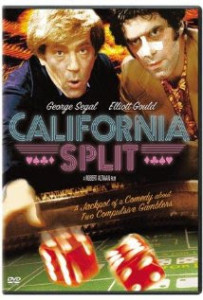
view/request
George Segal and Elliott Gould star in California Split, my all time favorite Robert Altman film and one of the best from the 1970’s. This dark, buddy comedy is centered around Bill Denny & Charlie Waters, two men who get sucked into the world of gambling. After Bill falls deep in debt to his bookie, he sells off several possessions so he and Charlie can make an all-in trek to Reno. They eventually find themselves in a tacky casino and in a dramatic, high stakes poker match.
Segal and Gould are the ultimate on screen duo with a perfect comedic volley and excellent chemistry. Additionally, this 1974 movie comes in when Altman was on top of his creative game. The director’s signature usage of wide range audio recording gives the picture an incredible depth and a real sense of place. The conversations from the extras and bit characters are always audible and usually rather interesting.
Ultimately, the story of California Split asks, does money really equal happiness?
Reviewed by Jason
Tagged: 1970s, Comedy, Drama, Feature film
The Artist
[DVD]
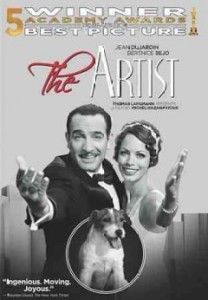
view/request
I had heard great things about Michel Hazanavicius’ award winning silent film The Artist. How could I not have? The film won five Oscars, three Golden Globes, and a host of other awards and critical praise. And yet, I was nervous about seeing the film. A silent film made in 2011? Was it just a gimmick? Just a superficial imitation of an earlier error?
There is no doubt that the film is intended as an homage to older films. The film is presented in black and white and everything from the acting, to the intertitles, the score, and even the aspect ratio of the screen is designed to resemble the films of the silent era. And yet, the film feels quite modern, in part, because of the self-awareness it brings to its imitation, but also because the film looks at Hollywood in the late twenties in a manner which could only be done in hindsight. In many ways The Artist has more in common with Singing in the Rain, another great film about Hollywood’s transition to talkies, than it does with any silent film.
And, much as with Singing in the Rain, you don’t actually have to be familiar with films of the silent era to appreciate The Artist. The film is well made, the acting is great, the period costumes are a joy. The characters are larger than life, but sympathetic and likable. They are caricatures, but this is so well done as to be an asset.
I really enjoyed The Artist. It’s funny, stylish, and clever. Recommended for film lovers or anyone looking for something a little different.
Reviewed by Ben
Tagged: 1920s, Feature film, Silent film
Moonstruck
[DVD]
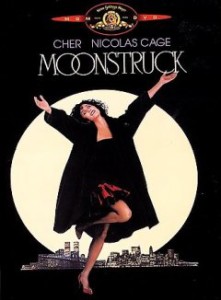
view/request
Norman Jewison’s Moonstruck is a film that’s been on cable television throughout much of my life, sitting on the shelves of various video stores and more recently, hanging out in the Forbes Library. The box artwork featuring Cher with her outstretched arms has always rubbed me the wrong way, perhaps signalling some sort of a cheeseball factor.
Recently I read an
interview with director Wes Anderson where he discussed his favorite New York films and to my surprise
Moonstruck made the cut. Jewison, who was a mentor to Hal Ashby, directs a delightful, modern day fairy tale filled with comedy, romance, beautiful and subtle camera work, brilliant character actor performances and just the right amount of nostalgia. Also standing out is the pitch-perfect dialog. John Patrick Shanley (other credits include
Joe Vs. the Volcano and
Doubt) creates a somewhat realistic family unit that is forever bickering with one another.
The story: Loretta (Cher), who has recently agreed to marry Johnny (Danny Aielo), is asked to track down her fiance’s estranged brother Ronny (Nicholas Cage) and invite him to their upcoming wedding. While Johnny is in Italy tending to his ailing mother, Loretta and Ronny wind up having an intense love affair. Chaos ensues!!! We also have Olympia Dukakis, Vincent Gardenia and John Mahoney in memorable supporting roles.
They say you can’t judge a book by its cover… and I think I’m now learning that you also shouldn’t judge a film by it’s DVD or VHS artwork!
Reviewed by Jason
Tagged: Comedy, Drama, Feature film
Stay Hungry
by Bob Rafelson
[DVD]
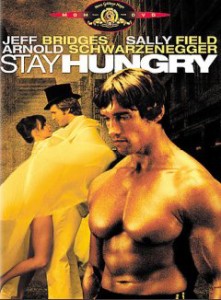
view/request
There’s just something about the “New Hollywood” films of the 1970’s… The budgets were smaller, but the films seem to resonate so much more than your typical, bloated Hollywood picture. With less resources, the directors of these movies focused on telling stories.
Bob Rafelson’s Stay Hungry tells the story of a recently orphaned grown, southern man named Craig Blake (Jeff Bridges). The opening shot is of the beautiful Blake estate and the narration of a letter read by Craig’s uncle advising his nephew to continue the family tradition and get into steel business. The younger Blake ignores his relative’s advice and teams up with a group of shady real estate sharks to buy out the businesses in a downtown building to may way for an office high-rise.
His colleagues are quickly successful in securing the property and they impatiently await Blake’s seizure of the last independent establishment, a local gym. Here Blake meets a cast of interesting characters including the beautiful, small town receptionist Mary Tate Farnsworth (Sally Field) and the zen body builder/fiddle player Joe Santo (Arnold Schwarzenegger). After visiting on several occasions trying to get the nerve to make an offer from the manic gym’s owner, Blake, a man who recently lost those close to him, finds a surrogate family with the regular gym rats and also eventually falls for Mary Tate.
The struggle to seize the gym, a conflict between the various classes of wealth depicted, an upcoming Mr. Universe pageant, the sometimes troubled romance of Craig and Mary Tate and an exceptionally strange and lengthy fight sequence, make Stay Hungry a wonderful comedy/drama piece. The principle actors all give some of the best performances of their careers and the film is full of unforgettable featured players.
Reviewed by Jason
Tagged: 1970s, Bodybuilding, Feature film
The Trip
by Michael Winterbottom
[DVD]
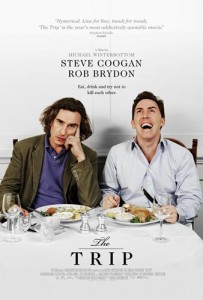
view/request
This feature mockumentary, edited down from a BBC television series, stars Steve Coogan and Rob Brydon as exaggerations of themselves in the entertaining fictional road movie, The Trip. The two colleagues continue their antagonistic relationship that began on the screen with Winterbottom’s A Cock and Bull Story. Coogan initially asks Mischa, his American girlfriend, to accompany him on an assignment where he’ll be writing a magazine piece covering restaurants and quaint inns in the northern English countryside. We soon learn the actor’s relationship is in trouble and he reluctantly calls on comedian Rob Brydon to join him.
What follows is a one upmanship contest of mythic proportions. The two bicker over their careers, public perception, height and general approach toward life. In the car and at various breakfast, brunch, lunch and dinner tables they battle it out with celebrity impersonations, vocal range and improvisational wars. The comedic competition is never ending, but never ceases to be funny. Contrasting the humor is Coogan’s desperation in private moments. Cell phone conversations (with a weak signal) to Mischa, his ex-wife, son and agent reveal the actor’s lonelier side and his frustration dealing with aging.
The uncredited supporting role of this film are the beautiful hills and mountains and the elaborate dishes Rob and Steve are served. Most importantly however, the friendship seen on screen, though obscured by Coogan’s condescension and bitterness, is rather touching at times. Despite his best efforts to isolate himself, this is possibly a story about meaningful human relationships.
Reviewed by Jason
Tagged: Comedy, Feature film, Food

view/request
Film recommendations certainly play a role in a day’s work at the Arts & Music department. It’s often my favorite task to help someone find a film that fits their taste and am always flattered when a patron asks for me to select something that I enjoyed. Recently, the favor was reciprocated. A regular patron suggested, based on our many movie conversations, that I might enjoy the film Kes. He was correct and to continue the dialog, here’s my take:
Kes is a story that I consider the Northern England equivalent of Truffaut’s 400 Blows. Made a decade later, director Ken Loach, who certainly chooses not to glamorize youth or pander to children, creates a nearly bleak portrait of childhood. His central character, Billy Casper, lives in a poor, working class mining community and seems to have his future decided for him at 15 years of age. While not absolutely going for the heavy handed approach, Loach is suggesting flaws in, what he considers, the still existing English class system.
Billy eventually finds an escape from the constant bullying from adult figures (his headmaster, classmates, older brother, gym teacher, etc.) when he notices a nest on a neighbor’s property. He studies the science of training birds and eventually develops trust with a kestrel he appropriately christens “Kes”. His dedication and care earns him the respect from a group of classmates and a caring English teacher (who is possibly the only kind adult in the film).
Kes, which is heartbreaking and desolate feeling at times, is a remarkable work. Loach’s nonjudgmental camera style, the simple and lyrical imagery, the falconry scenes with young Billy’s textbook narration and soft English landscape gives the film a quality not unlike a documentary.
Reviewed by Jason
Tagged: British film, Drama, Falconry, Feature film












